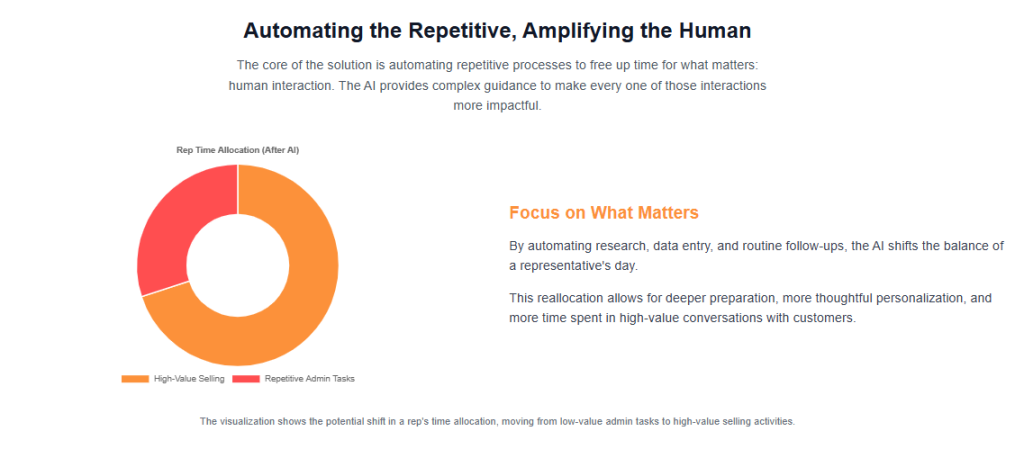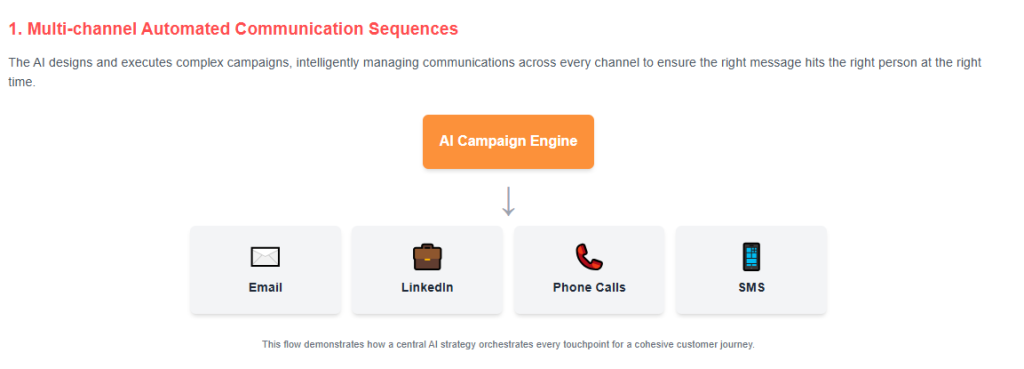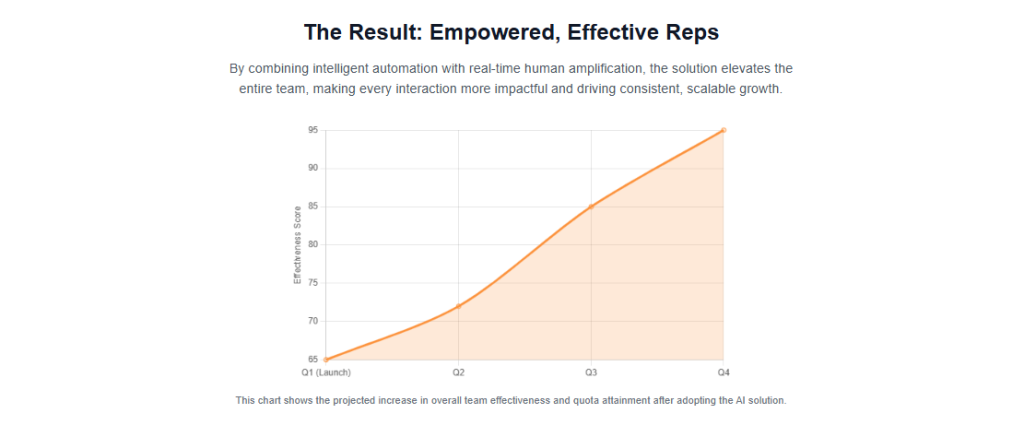
Intelligent Interaction and Communication with Customers using AI
Is your sales team drowning in tools?
Reps start their day in a sales engagement platform (SEP) like Salesloft or Outreach.
Then, they jump to a conversational intelligence (CI) tool like Gong to review a call.
Finally, they manually update everything in Salesforce.
This “swivel-chair” workflow is a nightmare. It’s a costly, inefficient “hairball” of disconnected point solutions that kills productivity.
For years, this was the only way. You bought the “best-of-breed” tool for each job and tried to tape them together.
That era is officially over.
A fundamental shift is happening, driven by Generative AI. The market is rapidly converging toward a single, intelligent “Unified Sales Co-Pilot.”
This isn’t just another new feature; it’s an entirely new way of selling. This article breaks down this disruption, what these new platforms do, and how you can build a winning strategy around them.
The Great Unification: From “Tool Sprawl” to Intelligent Platform
For the last decade, the dominant strategy for sales leaders was building a “best-of-breed” stack.
This led to a technical and operational mess. With over 1,300 AI sales tools on the market, most companies just created more “noise than clarity.”
The biggest point of friction has always been between the two most critical sales functions: prospecting and conversing.
This forced companies to adopt and pay for two distinct, expensive, and non-integrated platform types:
- Sales Engagement Platforms (SEPs): Like Salesloft and Outreach, built to automate prospecting “cadences.”
- Conversational Intelligence (CI) Platforms: Like Gong and Chorus, built to record and analyze post-call data for coaching.

This fragmentation forces reps to “swivel-chair” between systems all day, wasting hours on “time-consuming data entry” instead of selling.
This “tool sprawl” isn’t just an inconvenience; it’s a massive financial and strategic liability.
You are effectively paying two or more vendors to cover what should be a single, cohesive sales workflow.
The technological stalemate has finally been broken by Generative AI.
GenAI is the technological bridge that can finally unify these disparate functions.
It’s now possible for a single platform to be best-in-class at prospecting, personalizing, and coaching.
This has triggered a “race to unify” among all the major vendors, and the old “best-of-breed” model is collapsing as a result.
The Three Pillars of the AI-Powered Sales Co-Pilot
So what does this new “unified platform” actually do?
It’s not just a bundle of features. It’s a single, end-to-end workflow built on three core functional pillars.

1. Intelligent Sales Engagement (Not Just Cadences)
The first pillar is the evolution of the sales “cadence.”
The Old Way: A static, linear sequence. A sales manager would design a rigid series of steps (e.g., “Day 1: Email,” “Day 3: Call”) that was executed identically for every prospect.
The New Way: An intelligent and dynamic “orchestration.”
The critical shift is from simple “automation” to “orchestration.”
The platform is multichannel by design, managing email, LinkedIn, SMS, and calls as one coordinated experience.
This enables “adaptive engagement.”
Instead of just spamming, the AI tracks prospect interactions on one channel and uses that data to inform the action on another.
For example, the AI tracks that a prospect accepted a LinkedIn connection request but did not reply to the initial message.

This specific signal automatically triggers the next step: an email follow-up that references the new LinkedIn connection.
The role of your RevOps team fundamentally changes.
They no longer need to design the “perfect” static sequence.
Their new job is to become an “AI Governor.” They set the objectives (e.g., “book a meeting”) and the “guardrails” (e.g., “do not email more than twice a week”).
The AI is then empowered to autonomously learn, test, and execute the most effective sequence for each prospect within those boundaries.
2. Generative AI Hyper-Personalization (Not Just Mail-Merge)
The second pillar is the content engine that feeds those intelligent sequences.
This goes far beyond traditional mail-merge fields like [FirstName] or [Company].
The true power here is not the AI generation of text, but the automated research and data synthesis that happens first.
A public LLM (like ChatGPT) can write an email, but it has no context.
The unified sales platform acts as a powerful synthesis engine, integrating and analyzing data from three distinct sources at the same time:
- Internal CRM Data: All past purchase history, previous support ticket issues, and interactions with other reps.
- Web & Engagement Data: The prospect’s real-time “buying signals,” like their behavior on your company’s website.
- Public & Third-Party Data: The “hook.” The AI actively scans the internet for “company news, job changes, and funding rounds.”
Only after synthesizing these data points does the AI generate the message.
This “contextual crafting” means instead of a generic, “I see you just raised a Series B”…
The AI drafts a message that demonstrates an understanding of that event’s implications:
“Saw your recent Series B announcement; scaling from 5 to 15 SDRs often creates challenges in territory design. I have a few ideas on how…”
This is how sales teams can finally scale quality and relevance, not just quantity.
3. The Live Co-Pilot (Not Just Post-Call Review)
This third pillar is the most significant technological leap.
Legacy CI platforms like Gong were powerful but passive. They were “post-call review” tools. You analyzed a rep’s performance after the call was over and the deal was (potentially) lost.
The new model is an active, real-time co-pilot.
The AI actively listens to the live sales call and provides “in-the-moment guidance” and “live nudges” directly on the representative’s screen.
This technology is designed to change the outcome of the current call, not just provide analytics for the next one.
This live guidance appears in two main forms:
1. Objection Handling (“Battle Cards”):
The AI uses NLP to listen for keywords. When a prospect says, “This seems too expensive,” or “We already use [Competitor Name]”…
The AI instantly surfaces a “Content Card” or “battle card” on the rep’s screen with the approved talking points and key differentiators.
2. Methodology & Process Compliance:
The AI co-pilot displays your company’s chosen sales methodology (e.g., MEDDIC, BANT) as an on-screen checklist.
Using real-time speech recognition, when the AI hears the rep ask a required question (e.g., “What is the budget allocated for this?”), it automatically checks that item off the list.
This ensures no critical discovery questions are ever missed.

The Market “Race to Unify”: Who Is Winning?
This convergence has triggered a high-stakes “race to unify” among the largest SalesTech vendors.
Each is desperately trying to build or buy the functions they lack, creating a complex and confusing procurement landscape.
The primary vendors are approaching this from three distinct starting positions.
Strategy 1: The CI Leader Building Engagement (Gong)
- Starting Point: Market leader in Conversational Intelligence (Function 3).
- The “Build” Effort: Gong launched “Gong Engage” to build sales engagement (Function 1) capabilities.
- Market Reality: This has been met with significant resistance. Analyst reports and user reviews state that its engagement features “lack” the power of dedicated SEPs, forcing many to still use a two-tool stack (Gong + an SEP).
Strategy 2: The SEP Leaders Building CI (Salesloft & Outreach)
- Starting Point: Market leaders in Sales Engagement (Function 1).
- The “Build” Effort: Both vendors are aggressively building CI (Function 3) capabilities to compete directly with Gong (e.g., Outreach Kaia).
- Market Reality: This is the primary market battleground. Their CI features are natively integrated into the rep’s prospecting workflow, which is a massive advantage for adoption. However, their post-call analytics may still be less mature than Gong’s.
Strategy 3: The CRM Platform (Salesforce)
- Starting Point: The “platform of record”—the CRM itself.
- The “Integrate” Effort: Salesforce is leveraging “Einstein GPT” and “Agentforce” to embed all three functions (Sequences, GenAI, and Coaching) natively into the core Sales Cloud.
- Market Reality: Salesforce is the only vendor that can claim a truly unified data model. The trade-off? It comes with a “very high cost” and a “steep learning curve,” making it “too bloated for small teams.”
Platform Unification Matrix
This table synthesizes the competitive landscape for GTM leaders.
| Platform | Core Market Position | Function 1: Multi-channel Sequences | Function 2: GenAI Personalization | Function 3: Real-time Coaching | Overall Unification Assessment |
| Gong | Conversational Intelligence (CI) | Poor (Failing) “Gong Engage” “lacks sales engagement” per users. | Moderate “Smart Email Assist” exists but is secondary to call analysis. | Excellent (Post-Call) Best-in-class for post-call analysis. Lacks mature real-time features. | Fragmented. Forces a “two-tool” stack (Gong + SEP). |
| Salesloft | Sales Engagement Platform (SEP) | Excellent “Dominates cadences”; excels in email automation. | Good “Conductor” AI and “Rhythm” (AI Task Prioritization) are core. | Poor (Weak) Rated as having “minimal conversation analytics.” | Fragmented. Forces a “two-tool” stack (Salesloft + CI). |
| Outreach | Sales Engagement Platform (SEP) | Excellent Market leader for enterprise-grade, complex outbound. | Excellent “Smart Email Assist”; AI generation is central to its workflow. | Good (In-Workflow) “Outreach Kaia” provides real-time “Content Cards.” | Good. The closest of the “best-of-breed” players to achieving a truly unified platform. |
| Salesforce | Customer Relationship Mgmt (CRM) | Good Native “Sales Engagement” platform for cadences. | Excellent “Einstein GPT” has native access to all CRM data. | Good “Agentforce” provides “real-time tips.” | Excellent (Natively). The only truly unified data model. Trade-off is high cost and complexity |
The Human-Centric Mandate: Avoiding the “Creepy” AI
The core premise of this technology is not to replace salespeople. It is to unleash them.
The strategic goal is “Human-Centric Selling.” This is achieved by splitting the tasks of a sales professional:
- Tasks for AI (Automation): The AI is assigned all “mundane tasks,” “repetitive processes,” and “time-consuming data entry.” This includes prospecting, data enrichment, CRM updates, and drafting initial emails.
- Tasks for Humans (Augmentation): By automating the administrative burden, the AI frees up the sales rep to focus exclusively on high-value, uniquely human skills: “building personal relationships,” “emotional intelligence,” “empathy,” and “complex problem-solving.”
This human-centric mandate, however, creates the central strategic challenge of this new era: the “authenticity paradox.”
Customers, now more than ever, demand personalization. Research shows 71% of consumers expect companies to deliver personalized interactions.
Yet, they are also highly sensitive to inauthentic or over-automated attempts. The same research shows 76% of consumers get frustrated when this personalization is done poorly.
When AI-driven personalization is too accurate or too personal, it crosses a line from “convenient” to “creepy.”
The risk is that AI-generated content, which “lacks emotional intelligence,” will sound “formulaic.” This can lead to rapid “trust erosion” and significant brand damage.
This is where E-E-A-T (Experience, Expertise, Authoritativeness, Trustworthiness) and YMYL (Your Money or Your Life) principles become critical.
You must have governance frameworks to manage data privacy (GDPR/CCPA) for call recording and to audit your AI models for “algorithmic bias.”
The only viable solution to this paradox is to reject full automation.
You must mandate “human-in-the-loop” workflows.
In this model, the AI’s role is to draft, not to send. The AI provides the data-driven insight; the human provides the impact.
The greatest risk is that your reps will be tempted to outsource their empathy to the AI.
A successful deployment requires a “human-centric” training program that teaches reps to use the AI as a research assistant while trusting their own judgment to build the actual human connection.
The Future (2026+): From Co-Pilots to Autonomous Agents
The unified co-pilot is the dominant trend of today.
The dominant trend of tomorrow (2026 and beyond) is the shift from “AI Co-Pilots” to “Autonomous AI Agents.”
This is a fundamental architectural shift. Legacy platforms are “bolting on” GenAI features. New “AI-Native” platforms are being built from the ground up on “autonomous agent technology.”
The future of the sales platform is not a single “co-pilot” but rather a team of specialized, contextual AI agents that perform specific revenue-critical functions:
- “CRM Manager Agent”: Autonomously listens to calls and populates structured CRM fields (not just call notes), solving the data hygiene crisis.
- “Forecaster Agent”: Automates bottom-up forecasting, flags at-risk deals, and generates the one-page presentation deck for the weekly forecast meeting.
- “Prospector Agent”: Works 24/7 to conduct deep account research, identify “hooks,” and generate personalized email drafts.
This “autonomous agent” future will have a profound impact on organizational design.
While the “co-pilot” platform primarily augments the sales representative…
The “autonomous agent” platform will primarily automate the administrative and analytical tasks of the sales manager.
This will force the manager’s role to evolve—away from being a “data inspector” and “forecaster” and toward becoming a 100% “human coach.”

Your Strategic Action Plan
This disruption isn’t coming; it’s already here. The “tool sprawl” model is broken, and the “race to unify” is on.
Here are your strategic recommendations for navigating this new era.
1. Prioritize Unification. Reject the “Stack.”
The era of the “best-of-breed stack” is over. This model is inefficient, expensive, and creates data silos. The “tool sprawl” itself is now the primary bottleneck to productivity.
Action: Make unification a non-negotiable procurement criterion. Force all vendors to demo all three functional pillars (Sequences, GenAI Personalization, and Real-Time Coaching). Disqualify vendors who cannot demonstrate a deeply integrated, “single-pane-of-glass” workflow.
2. Adopt a “Practice-First, Perform-Second” Model.
The “Live Co-Pilot” (Function 3) is powerful, but it carries high risks of rep rejection and skill degradation. Reps may perceive it as intrusive or use it as a “crutch,” which can atrophy their own skills.
Action: Mitigate this adoption risk by deploying AI coaching in two phases. First, onboard all reps onto an “AI Sparring Partner” (AI roleplay) platform. This lets them build confidence and muscle memory in a “safe environment.” After they are proficient, introduce the “Live Co-Pilot” as an escalation tool for high-stakes calls.
3. Mandate “Human-in-the-Loop” to Win the Authenticity War.
The “authenticity paradox” is the single greatest strategic risk of this technology. The fastest way to fail is to allow reps to “copy-paste” AI-generated messages or read on-screen scripts verbatim. This will be perceived as “creepy” and “inauthentic,” and it will erode brand trust.
Action: Implement a “human-in-the-loop” mandate for all external communication. The AI’s job is to draft. The sales rep’s job is to finesse and add human empathy. This “human-centric” approach is the only sustainable competitive advantage.

